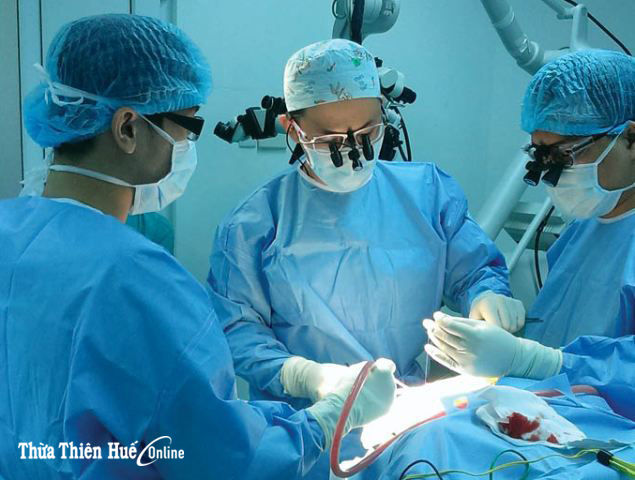
Dr. Truong Van Tri (middle) and the team who performed the surgery on Le H.
The first surgery
The first patient to be successfully cured using this method was Le H. (21, from A Luoi). As a child, he was diagnosed with epilepsy, which has negatively affected his learning abilities. Two years ago, the frequency of epileptic fits increased, reaching as high as 1-3 times per day. The patient took various anti-seizure medications, but the result was insignificant, and he was unable to work. Based on clinical examination, Electroencephalogram (EEG) and Magnetic Resonance Imaging (MRI) results, the hospital’s neurosurgeons diagnosed him with temporal lobe epilepsy caused by right sided hippocampal sclerosis, and decided to surgically remove the temporal lobe on the right side of the brain.
“Before the surgery, the patient and his relatives were quite worried as this was a brain case. If accidents were to happen, it could lead to dire consequences, even death. Despite having been informed that the incidence of accidents happening was low, the patient was still nervous and anxious. He and his family finally agreed to have a surgery after reconsiderations, seeing that his low quality of life and inability to work due to frequent fits made him a burden on his family.” - Dr. Truong Van Tri – Head of the Neurosurgical Unit at Hue University Hospital shared. “After the surgery, I no longer have seizures like before. Now I can go to work instead of staying at home. Needless to say, my family and I are very happy,” H. said.
“There were plenty of pressures during the first operation, especially the determination of curing our patient of epilepsy, giving him his normal life back, thereby ensuring patients’ as well as our colleagues’ hope that surgery can be a way out for drug-resistant epilepsy patients,” Dr. Tri recalled his emotions after 7 hours of the first epilepsy surgery on Le H.
Overcoming difficulties and obstacles
In order to implement the epilepsy surgery, Dr. Tri and other doctors at the Neurosurgical Unit had to overcome many difficulties. The important thing was to convince everyone that the surgery can help patients get rid of seizures. This is due to the fact that many of the medical staff as well as patients had doubts about the effect of surgery in treating epilepsy.
According to Dr. Tri, the first obstacle in epilepsy surgery was precise diagnosis. “In order to determine the right condition, the role of neurologists is critical. They are the ones who conduct neurological exams, read EER and MRI results to locate the source of epilepsy on the patient’s brain. This helps the surgeon a lot who will perform the operation, and the crucial objective is to remove the epilepsy source without damaging nearby neural structures. Accidents can come in form of infections, cerebral hemorrhage, paralysis…” he said.
Following the success of the operation, the neurosurgeons at the Neurosurgical Unit of Hue University Hospital have had another positive result from treating another epilepsy patient from Dak Lak, granting him a better life. In the near future, the hospital staff will continue carrying out more epilepsy surgery in order to help patients get rid of seizures, and return to their normal life.
By Ngoc Ha